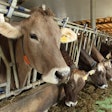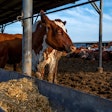
Report says meat and poultry prices hit record highs in mid-May
The already volatile U.S. grains prices continue to depend heavily on weather, while that volatility has been exacerbated by non-commercial speculation activity, according to a new CoBank report.
“Weather will now be the main catalyst driving grain prices over the next two months,” the report said. In the second quarter, “corn, soybean, and wheat prices first ascended to a 9-year peak but then non-commercial (speculative) buyers pulled back their positions, reducing their exposure as fears of runaway inflation tempered.”
While drought and excessive heat in much of the corn, soybean and wheat growing regions have affected crops, U.S. Department of Agriculture (USDA) production estimates do not yet reflect this.
“Suffice it to say, July weather will be critically important to the U.S. corn crop during pollination, while August (at this moment unpredictable) will be important for soybean and spring wheat development,” the report said. “Buckle up your seatbelts, the next phase of the grain run will not be one for the faint of heart.”
Animal protein
Meat and poultry prices hit record highs by mid-May, despite low prices early in the year. The report cited prices for jumbo wings at more than US$3 per pound, ribeye at more than US$11 per pound and pork bellies at more than US$2 per pound.
“Chicken industry margins have markedly improved from the worst of 2020,” CoBank said. “Given the price and feed outlook, profitability should remain strong through the end of 2021.”
Pork has been one of the highest-rising commodities this year, with lean hog futures hitting US$122 in mid-June, while August feeder cattle futures are trading near US$160, the report said.
Although beef prices are at near-record highs, “cattle ranchers and feeders are currently caught in a vise between maxed-out national slaughter capacity and the liquidation pressures of exceptional drought hitting the western U.S. combined with high feed costs,” the report said.
Despite high feed costs and high temperatures, milk production continues to hit record highs, causing prices to hit their lowest levels in seven months.
Foodservice and grocery store sales are strong as more people return to dining out and higher-income Americans spend more on food at home. The biggest concern across the supply chain, the report said, is labor availability, from farm to supermarket.















